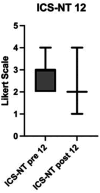Learning and working on an interprofessional training ward in neonatology improves interprofessional competencies
- PMID: 39975684
- PMCID: PMC11835851
- DOI: 10.3389/fmed.2025.1483551
Learning and working on an interprofessional training ward in neonatology improves interprofessional competencies
Abstract
Introduction: Interprofessional education (IPE) is essential for healthcare professionals to prepare them for future interprofessional collaboration (IPC). Interprofessional training wards (ITWs) have been set up for IPE and results have been published. There are no published studies on ITWs in neonatology. We have designed and established the Interprofessional Training Ward in Neonatology (IPANEO) for nursing trainees (NT) and medical students (MS) in a neonatological intermediate care (IMC) ward. We report on the concept and the results with regard to the interprofessional competencies of the participants, including parent satisfaction.
Methods: Supervision by medical and nursing learning facilitators, 2week blocks each with 2 NT (n = 30) and 2 MS (n = 23) in their final year, ward-in-ward concept, 3 patients cared for. Evaluation of the participants (pre/post) with the Interprofessional Socialisation and Valuing Scale (ISVS), the Interprofessional Collaboration Scale (ICS) with questions on IP communication, accommodation and isolation as well as with an IPANEO-specific evaluation (IPQ), an external evaluation with the "Observational Questionnaire for Learning Facilitators" (OQLF) and a "Questionnaire on Parent Satisfaction" (PSQ) (n = 33).
Results: IPANEO participants showed significant increases in competencies in IP communication, accomodation and isolation (ICS), a better IP-collaboration and a higher role definition (IPANEO specific questionnaire). The ISVS 9A/B global scores increased. According to the self-assessment there were significant improvements in the external evaluation in all IP-categories (OQLF). The feedback from the parents was significantly positive (PSQ).
Conclusion: Interprofessional learning and working on IPANEO had a positive impact on interprofessional competencies with high parent satisfaction.
Keywords: interprofessional competencies; interprofessional learning; interprofessional practice; interprofessional training ward; interprofessionality in neonatology.
Copyright © 2025 Schwarz, Straub, Bode, Ferschl, Brickmann, Berberat and Krüger.
Conflict of interest statement
The authors declare that the research was conducted in the absence of any commercial or financial relationships that could be construed as a potential conflict of interest.
Figures




References
-
- Ewers M, P E. Interprofessional learning, teaching and working. Weinheim: Beltz Juventa; (2019).
LinkOut - more resources
Full Text Sources
Research Materials

